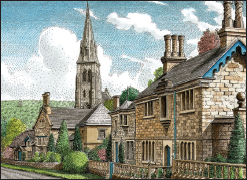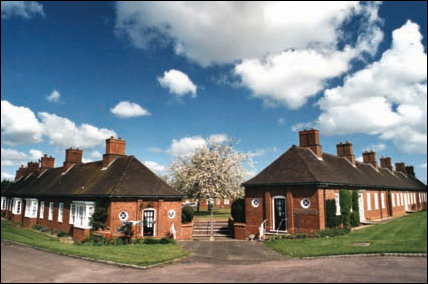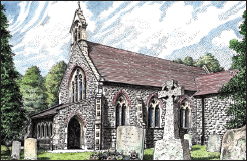The English Village Explained: Britain’s Living History (8 page)
Read The English Village Explained: Britain’s Living History Online
Authors: Trevor Yorke

Another limitation on the development of a settlement and the form it would take was whether it was open or closed. If the village was dominated by a resident squire or an interested but absent lord who probably owned the majority of the land, then he could control it and close its doors to undesirables (hence, a closed village). The physical signs would be a neat, planned layout, a number of large farms, housing of a good quality but limited availability, and probably only one pub and shop. Although the villagers may have benefited from low rents, they would have had to do as the landowner wished, and that could include following certain religious practices and having particular political leanings. In contrast an open village was one without these controls where there were numerous smallholders, a large proportion of working class families and local industries. These would usually be unplanned settlements with poorer housing, a large number of pubs and shops, and nonconformist chapels, where the villagers would pay rent but had freedom in employment and personal beliefs. It is in these open villages where you are more likely to see population growth in the 19th century.
The expansion of settlements and the establishment of new villages also occurred when railways, mines, mills and factories developed. In some cases ragged sprinklings of houses and terraces and rough grazing surrounded the workings; whilst in others benevolent owners or companies created neat model housing, new churches and schools or even complete villages for their workers. The growth of an increasingly large and diverse military force in the 19th and 20th
centuries also led directly to the founding and expanding of settlements as army, naval and air force bases engulfed old hamlets creating modern villages with regimented rows of barracks and family homes, shops, churches and social facilities. After the Second World War, the introduction of National Parks and the growth of conservation bodies like the National Trust has led, in effect, to great swathes of the countryside coming under the influence of new landlords. Villages which fall into these areas have been protected and preserved with restrictions sometimes not just limiting building but also maintaining the numbers who work in local industry, crafts and farming.

FIG 5.5 EDENSOR, DERBYS:
A fine closed estate village created for the Duke of Devonshire in the early 1840s as he wished the old settlement removed out of sight of his Chatsworth House. Cottage-style buildings with a jumble of periodic details are typical of estate villages in the early and mid 19th century
.
Despite the expansion of villages in response to military, industrial and urban demands, these same pressures have also led to the removal or abandonment of some in recent times. Some settlements had to make way for Second World War airfields, while the M.O.D. cleared hamlets and farms to create training grounds. The urban demand for water also forced some councils and companies to build reservoirs, thus flooding valleys and causing the destruction of villages. Numerous declining industrial or agricultural settlements were finally abandoned in the 20th century when councils refused to make up roads or provide services. The remaining inhabitants were therefore forced to move into new towns while their old homes were either left to ruin or bulldozed.

FIG 5.6 SALTAIRE, WEST YORKS:
During the 1850s and 1860s Titus Salt built a complete village to house workers for his new mill, naming it after himself and the adjacent River Aire
.

FIG 5.7 STEWARTBY, BEDS:
This modern village was created in the inter-war years to house workers at the new brickworks. It still has its school, shop and community centre as originally planned although much of the brick production in the locality has ceased
.
After years of stagnation the Church of England sprang into action in the mid 1800s and started building new
churches and developing parishes to reflect the changes in urban and rural communities, while a revival in the faith saw most existing churches restored or renovated. Roman Catholics were freed from restrictions dating back to the 16th century and from the 1830s began building their own churches, while the fortunes of dissenting groups and their chapels fluctuated under the wave of orthodox revival.

FIG 5.8 MARDALE GREEN, CUMBRIA:
In 1940 this village vanished below the new Haweswater Reservoir built to supply water to Manchester. In droughts the remains of its walls and a bridge can still be seen, as in this view from 1976 (from photographs by J. O’Ryan)
.
Along with the changes in local government and the birth of county councils, civil parishes were formed in 1889 to administer matters in the village. It is the boundaries of these secular bodies and not the earlier ecclesiastic ones which are marked on Ordnance Survey maps. In many cases the two boundaries will match as these new civil parishes were laid out to reflect the separate areas of Poor Law administration.
As villages by the 1800s had developed into specific types rather than being primarily agricultural, the social structure of these rural communities does not fit into any neat generalisation. The type of people who made up a community could depend on whether the village was an open, unregulated settlement with nonconformist chapels or was closed within an estate where the Church of England was more influential.
The lord of the manor could still be a major aristocrat, a gentleman or a squire although by the mid 19th
century, estates were increasingly being purchased by successful industrialists and capitalists. Some were absent from what may have been just one of many estates they owned while others took an active interest in their agricultural and industrial development. Most, though, enjoyed hunting and, from the late 19th century, shooting, too. This would have required a gamekeeper responsible for the control, protection and breeding of the game animals and birds and a huntsman to look after the foxhounds while the Master of the Hunt, who may have been the lord himself, had overall control of the pack. Other members of staff on a Victorian estate included gardeners, coachmen, butlers, maids and cooks while the tenant farmers would employ labourers who made up a shrinking proportion of the village population. The gentry’s lavish lifestyle and estate farms still provided most of the employment in the dependent settlement.

FIG 5.9 LITTLEWICK GREEN, BERKS:
This small church built in the late 19th century is typical of many erected in new and existing parishes to serve neglected congregations and remote areas
.
This is the age when the familiar village trades became full-time occupations, whereas previously many of these roles had been unpaid or combined with other work. The local vicar, rector or minister would have been among the most important individuals, along with the main farmers, while the schoolmasters or mistresses, parish clerks, constables and doctors were just below them on the village social ladder. Then there were the various tradesmen like blacksmiths, wheelwrights, carpenters, builders, butchers, bakers, grocers, tailors, cobblers, tanners, millers and publicans. If there was a local industry, then there could be iron workers, miners, quarrymen, brickmakers and masons. The transport of their goods would necessitate a stationmaster, signalman, and workers on the railways, a gatekeeper, surveyor and road men on the turnpikes, while on the canals there were wharfingers, lock-keepers, lengthsmen and boatmen.
The 20th century saw the decline and extinction of so many of the above roles from the landlord down to the humble labourer. Those that have survived have adapted to the changing times, while other craftsmen produce goods for tourists rather than villagers. Farmers have diversified by offering bed and breakfast, selling off barns for conversion and turning over land for camping, fishing lakes and other leisure activities. Old cottages have been renovated and extended, schools and chapels fitted out with domestic trappings, attracting commuters and the retired from towns and cities. Most villages in the early 21st century are dominated for the first time by the middle classes, filling the gaps vacated by labourers and tradesmen.
This brief journey through the past has shown how many villages were formed, developed and declined. Although we consider the changes in the past century to have been devastating to most rural communities these major shifts in the social and physical structure of villages have happened many times before. Deserted settlements, ridges and furrows and old market places are just a few of the remains today which show where this has occurred. Although romantic
images have crystallised what we regard as the traditional English village in our minds, the main reason for their survival over the past millennium is the way they have adapted to changes in agriculture, transport and industry, as many are again doing now as waves of urbanites alter the social and physical aspects of established communities. In the following section we will look in detail at the elements you can see in and around a village today and those less obvious features which show where changes have been made in the past.

